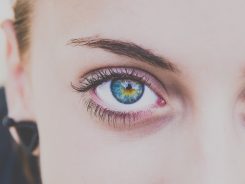Table of Contents
Eating disorders affect millions of people from all different backgrounds. A national survey estimates that 20 million women and 10 million American men will develop an eating disorder at some point in their lifetime. The Diagnostic and Statistical Manual of Mental Disorders recognizes several types of eating disorders, including the two that you are probably most familiar with, anorexia and bulimia.
The causes of eating disorders vary among individuals, but as with most mental illnesses, there are commonalities that can help guide professionals in the early stages of treatment. Two of the shared factors that can lead to an eating disorder are a person’s view of themselves (self-esteem) and their perception of how they look (body image).

Self-Esteem and Eating Disorders
Self-esteem and self-confidence are often used interchangeably, but each term reflects a different aspect of someone’s overall self-worth. Self-confidence is typically superficial in nature; people who come off as self-confident tend to be social, assume leadership roles and are good at motivating others. They may be quick to respond to an insult or criticism, and they may even seem like the type of person who can’t be affected by anyone else’s opinion of them.
Self-esteem is rooted much deeper than self-confidence, though. Self-esteem refers to a person’s beliefs about their worth and abilities. People can be extremely self-confident and have incredibly low self-esteem. In fact, exaggerated self-confidence can be a means of overcompensating for low self-esteem and little self-worth.
People with low self-esteem have a negative inner voice that leads to the development of their greatest insecurities. They may believe that they aren’t good enough or attractive enough or that they are undeserving of love and respect.
Low self-esteem can convince a person that they must change what they look like on the outside to be desirable and accepted by others. Over time, this belief gradually begins to distort their perception of what they look like and how they regard themselves and their body.
Body Image and Eating Disorders
Everyone has a few physical insecurities and things they would like to improve about themselves and their appearance. That doesn’t mean that everyone has an overall negative body image. However, some people have so many insecurities about their appearance that it overwhelms their perception of their bodies to become completely negative. People with a negative body image can distort their self-perception so much that they develop a condition called body dysmorphic disorder.
People who are body dysmorphic cannot stop fixating on certain aspects of their physical appearance. Whether it is their weight, shape or physical features they dislike, flaws that may not exist or be evident to anyone else, become blindingly obvious to the individual who perceives them.
When low self-esteem and a negative body image turn into body dysmorphia, eating disorders can arise. People may become so ashamed of what they think they look like that they avoid social situations, go to drastic measures to conceal or alter their appearance and even jeopardize their health to achieve their ideal look.
Eating disorders come in many forms, and the same disorder can present differently in different people. However, some signs to watch out for include
- Skipping meals or taking only small portions.
- Fixating on weight or body shape.
- Overexercising.
- Creating food rituals.
- Extreme dieting or cutting food groups out of their diet.
People exhibiting these signs may avoid or withdraw from social activities and interaction in order to hide or to cater to these preoccupations. You may also notice they have brittle hair or nails and dry skin due to lack of nutrition as well as mood swings, sleep issues or a weaker immune system. In the case of bulimia, they may also have dental issues and sores on their hands.
Getting Help
Low self-esteem and negative body image can be destructive to your body and your day-to-day life, but there are many resources designed to help you combat these issues and restore order to your life. There are two primary treatment options for eating disorders; someone can work one-on-one with a therapist or check into an in-patient program. The intensity of treatment will vary depending on the severity of the disorder, but all eating disorder therapy typically involves nutrition education and planning, talk therapy and self-esteem exercises.
It can be crippling to admit you have an eating disorder, especially if you have struggled in secret. Many people who have an eating disorder look perfectly healthy to outsiders, so family and friends are often shocked when a loved one reveals that they are struggling.
The National Association of Anorexia Nervosa and Associated Disorders has a helpline you can call Monday through Friday, 9:00 A.M. to 5:00 P.M. central time at 630-577-1330. You can also lookup therapists near you and schedule an appointment to start getting treatment for your eating disorder.















